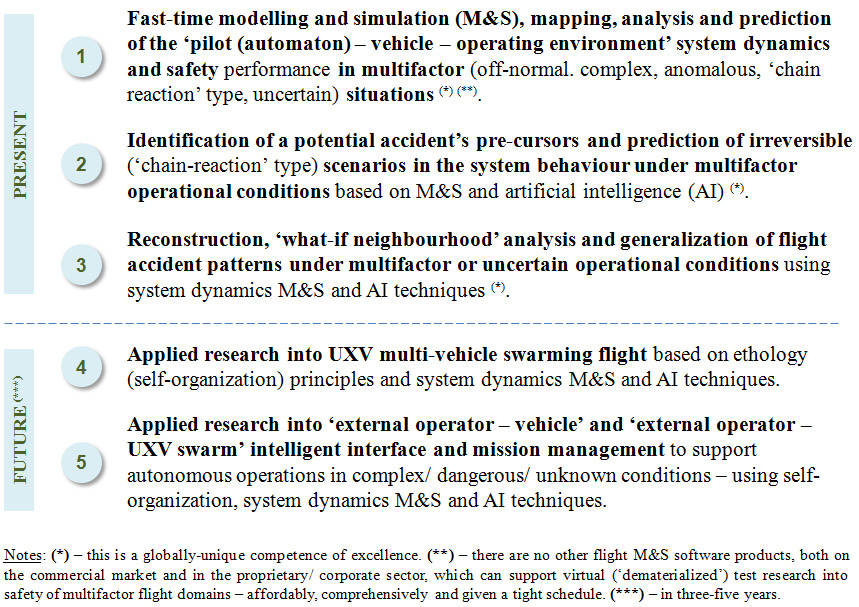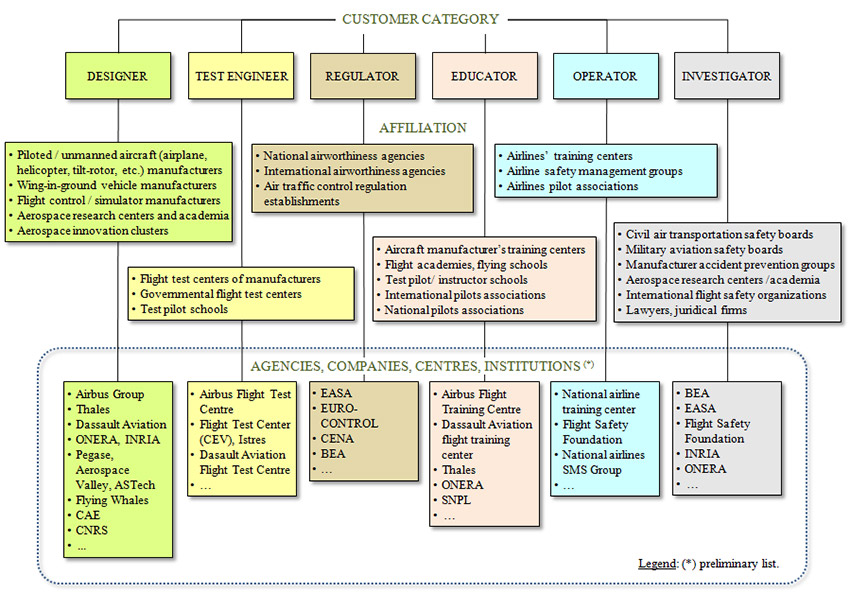Market Precursors for AIXTREE Business
1. Design complexity, life cycle cost and duration are growing for a new-generation vehicles à More time, budget and other resources are needed for R&D, T&C and pilot training.
2. Higher standards of flight safety are to be met à New techniques are required for R&D, flight test & certification, pilot training and aircraft operation.
3. There exist shortcomings in the established techniques used for flight performance and safety testing:
- Too expensive to set up.
- Too long to accomplish.
- Too many cases to be checked (the combinatorial ‘curse of dimensionality’)
- Too complex [technically] to implement test scenarios.
4. Only a few classes of complex operational scenarios can be screened in manned simulations and real flight tests in advance.
- Growth of the likelihood of vehicle being ‘under-tested’ under complex conditions.
- Increased risks of not revealing plausible anomalous scenarios before operations.
- Test and certification schedule and budget overruns.
5. Some vehicles are under-tested in multifactor situations, and this fact can be revealed only after an accident.
6. Certain shortcomings exist in aircraft certification, pilot training and accident prevention procedures.
7. Analytical potential of M&S based investigation is growing à It is getting easier to quantify the uncertainty in a multifactor accident rather than attribute it to a so called ‘pilot error’ or demanding weather (‘force majeure’).
8. The intensity of flight operations is increasing à The probability of aviation accidents and incidents can increase.
9. The fleet of vehicles using civil airspace is growing and getting more diversified:
- UAV, amphibious vehicles, flying cars, WIGs,
- Aerostatic and hybrid (aerostatic + aerodynamic) vehicles.
10. More relatively inexperienced operators (pilots, drivers, etc.) will probably enter
operational airspace.
AIXTREE SAS Competences of Excellence
Strategic Vision and Mission Statement
Company Vision
In five years, AIXTREE will be offering intelligent fast-time flight modeling and simulation products and services aimed at safety prediction and protection in complex or unknown situations.
These offerings will be based on the virtualization of millions of potentially unsafe realistic multifactor flight scenarios – before a real accident can happen.
Mission
Screen vehicle safety performance in multifactor situations at the level of the ‘pilot/ automaton – vehicle – operating environment’ system dynamics – comprehensively, proactively and affordably.
Overall Objective
Minimize the risks of unexpected anomalies in the system dynamics through early fast-time M&S based virtual flight test, certification, operation and pilot training.
Major Avenues for Research and Academic Work
Selected Topics for Research and Academic Projects
- Market analytics, R&D foresight/ roadmap/ program / plan drafts in M&S and AI fields.
- Theoretical concepts, mathematical models, numeric methods, computational algorithms, data structures, software technologies and system prototypes for safety research.
- Techniques and technologies for pilot modeling, simulation, training, activity analysis and optimization, pilot error prevention/ mitigation.
- Knowledge base and decision-making mechanism prototypes for AI systems for accident risk prediction and prevention.
- Virtual reality concepts, techniques and technologies for ‘vehicle(s) – operator’ intelligent interface and in-flight decision support for safety.
- Techniques and technologies for virtual flight test and certification of vehicles, mission planning, monitoring and support based on the system dynamics model.
- Accident reconstruction, its ‘what-if neighborhood’ analysis and cause-and-effect mechanism identification under uncertainty.
- Identification of anomalous flight scenarios in multifactor conditions. Development of recommendations on recognition and safe resolution of dangerous multifactor situations in operations.
- Techniques, technologies and prototypes of AI systems for multiple constraints violation prevention and obstacle collision avoidance.
- Technologies for multi-vehicle swarming system control, simulation, mapping, analysis and supervision including variable-autonomy unmanned systems.
- Short-term courses, workshops and conferences, and consultancy in the field.
- Lecture courses in M&S and AI for safety. Supervision of MSc and PhD student projects.
Potential Customers and Partners
Protecting Customer’s Information: AIXTREE Strategy
Vehicle design, flight test, certification, operation, pilot training and accident investigation are sensitive sectors. AIXTREE adheres to the highest standards of business transparency and customer’s information protection while carrying out R&D projects.
The most sensitive and valuable information object is a ‘parametric definition’ database for a new vehicle. However, a commercially sensitive ‘parametric definition’ is not required to release to AIXTREE in order to carry out M&S research into system dynamics.
In the system dynamics model, several alternative substitutes for a vehicle’s sensitive ‘parametric definition’ may be used. These options are:
- a ‘theoretical’ ‘parametric definition’, which is compiled using published data and virtual design methodology (UTA, AVD LLC, USA).
- a dummy ‘parametric definition’ developed for a notional/ standard vehicle, or
- published data for a known/ generic vehicle (e.g. from NASA Technical Reports library), or
- a ‘parametric definition’ of an old vehicle belonging to the same class as the sensitive vehicle, or
- a ‘black box’ type ‘parametric definition’ data module.
During the first phase of research, M&S experiments are carried out by AIXTREE staff using a substitute ‘parametric definition’ – ref. above. Then, the system model is transferred to the Customer to conduct experiments by its staff using sensitive data. The only constraint is that data representation formats must be the same in the real and dummy databases.
Also, a non-disclosure agreement must be signed to ensure that IP is protected for all the parties involved.
| << Previous page | Next page >> |


